Implementing Lean Project Management to Dream Home
VerifiedAdded on 2022/11/10
|15
|3859
|241
AI Summary
This article discusses the implementation of lean project management to build a dream home. It covers topics such as choosing the suburb, deciding the land size, choosing the best builder, stakeholders of the project, design and layout, and a detailed explanation of the project management process. It also provides a detailed explanation of how to achieve lean project management for this initiative.
Contribute Materials
Your contribution can guide someone’s learning journey. Share your
documents today.
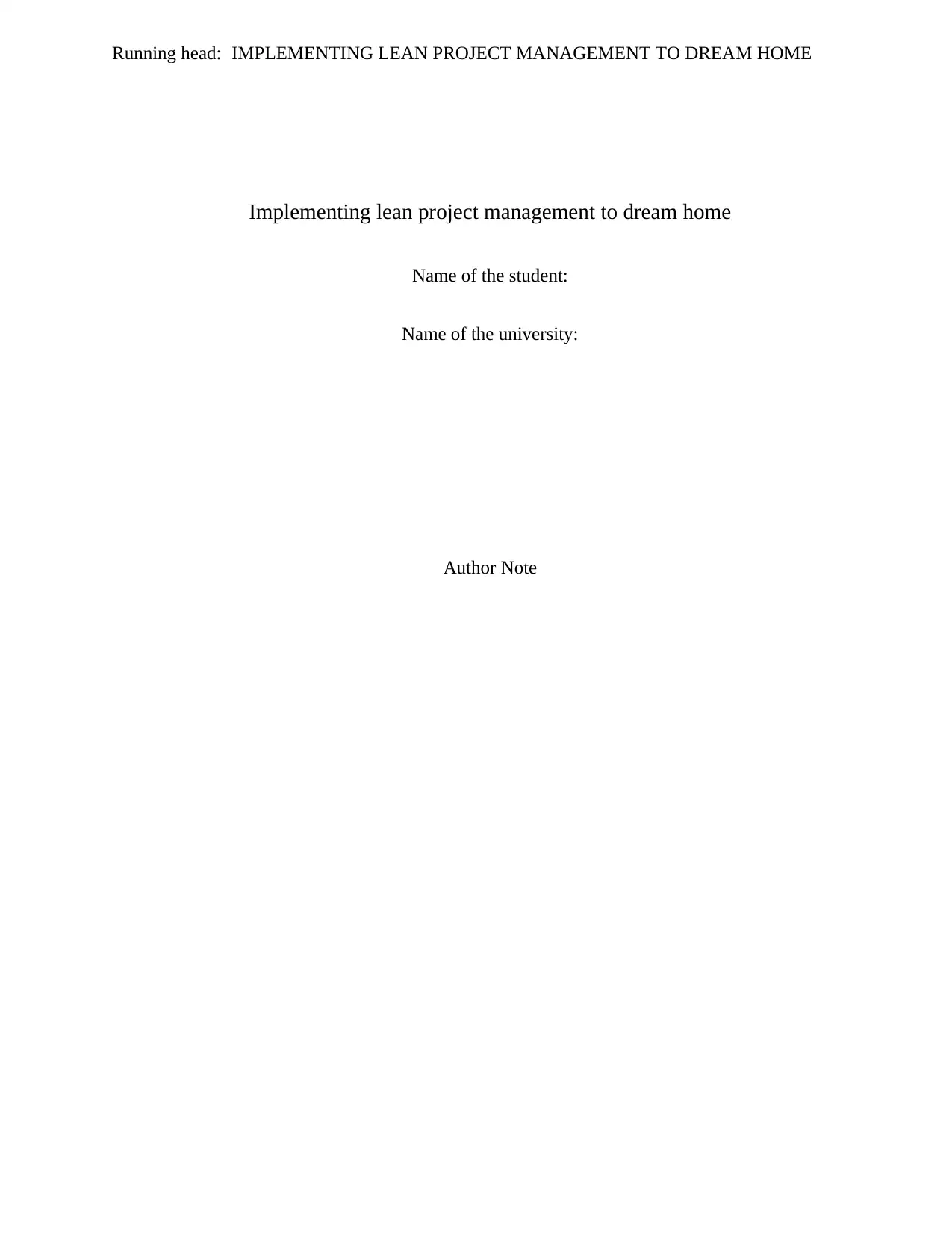
Running head: IMPLEMENTING LEAN PROJECT MANAGEMENT TO DREAM HOME
Implementing lean project management to dream home
Name of the student:
Name of the university:
Author Note
Implementing lean project management to dream home
Name of the student:
Name of the university:
Author Note
Secure Best Marks with AI Grader
Need help grading? Try our AI Grader for instant feedback on your assignments.
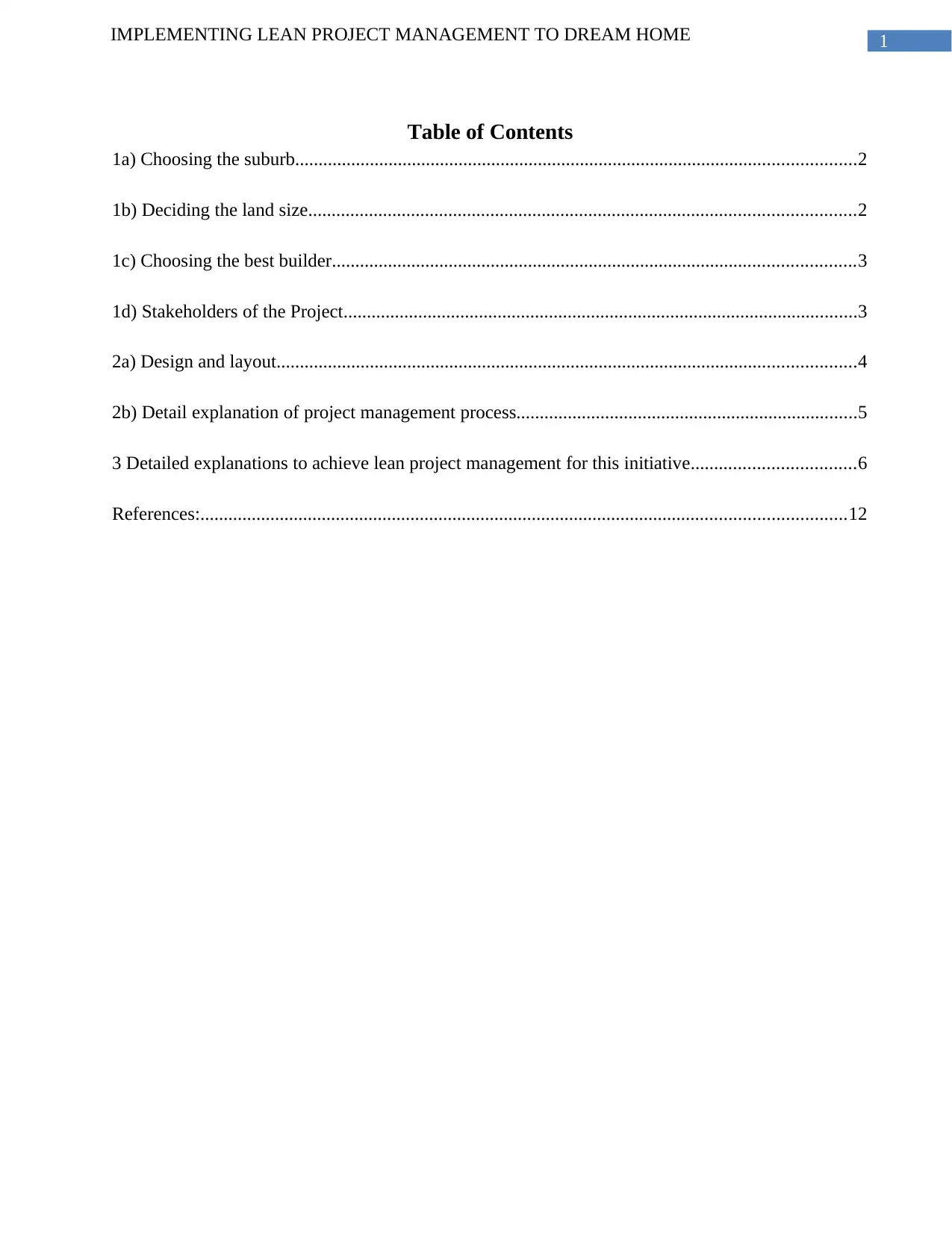
1IMPLEMENTING LEAN PROJECT MANAGEMENT TO DREAM HOME
Table of Contents
1a) Choosing the suburb........................................................................................................................2
1b) Deciding the land size.....................................................................................................................2
1c) Choosing the best builder................................................................................................................3
1d) Stakeholders of the Project..............................................................................................................3
2a) Design and layout............................................................................................................................4
2b) Detail explanation of project management process.........................................................................5
3 Detailed explanations to achieve lean project management for this initiative...................................6
References:..........................................................................................................................................12
Table of Contents
1a) Choosing the suburb........................................................................................................................2
1b) Deciding the land size.....................................................................................................................2
1c) Choosing the best builder................................................................................................................3
1d) Stakeholders of the Project..............................................................................................................3
2a) Design and layout............................................................................................................................4
2b) Detail explanation of project management process.........................................................................5
3 Detailed explanations to achieve lean project management for this initiative...................................6
References:..........................................................................................................................................12
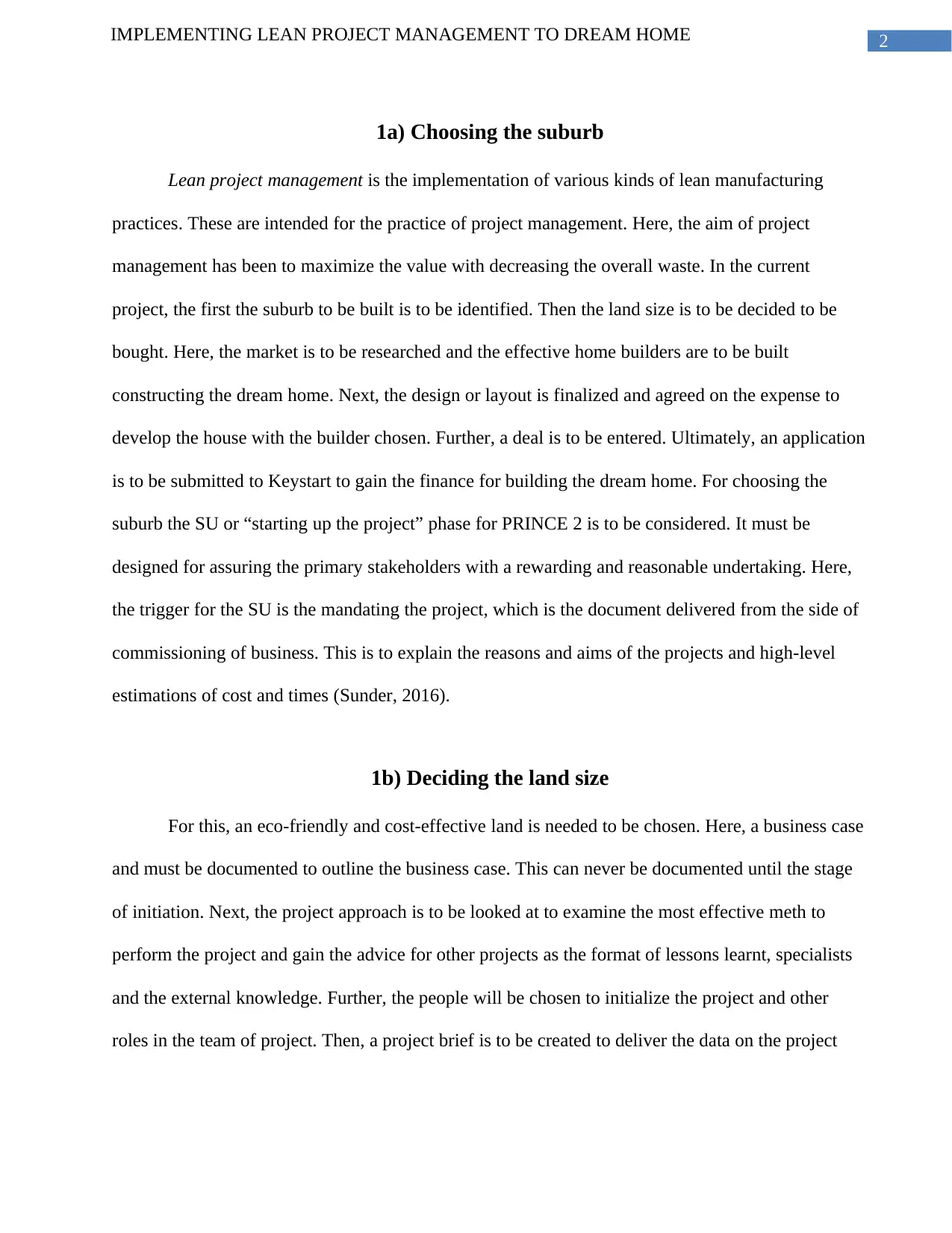
2IMPLEMENTING LEAN PROJECT MANAGEMENT TO DREAM HOME
1a) Choosing the suburb
Lean project management is the implementation of various kinds of lean manufacturing
practices. These are intended for the practice of project management. Here, the aim of project
management has been to maximize the value with decreasing the overall waste. In the current
project, the first the suburb to be built is to be identified. Then the land size is to be decided to be
bought. Here, the market is to be researched and the effective home builders are to be built
constructing the dream home. Next, the design or layout is finalized and agreed on the expense to
develop the house with the builder chosen. Further, a deal is to be entered. Ultimately, an application
is to be submitted to Keystart to gain the finance for building the dream home. For choosing the
suburb the SU or “starting up the project” phase for PRINCE 2 is to be considered. It must be
designed for assuring the primary stakeholders with a rewarding and reasonable undertaking. Here,
the trigger for the SU is the mandating the project, which is the document delivered from the side of
commissioning of business. This is to explain the reasons and aims of the projects and high-level
estimations of cost and times (Sunder, 2016).
1b) Deciding the land size
For this, an eco-friendly and cost-effective land is needed to be chosen. Here, a business case
and must be documented to outline the business case. This can never be documented until the stage
of initiation. Next, the project approach is to be looked at to examine the most effective meth to
perform the project and gain the advice for other projects as the format of lessons learnt, specialists
and the external knowledge. Further, the people will be chosen to initialize the project and other
roles in the team of project. Then, a project brief is to be created to deliver the data on the project
1a) Choosing the suburb
Lean project management is the implementation of various kinds of lean manufacturing
practices. These are intended for the practice of project management. Here, the aim of project
management has been to maximize the value with decreasing the overall waste. In the current
project, the first the suburb to be built is to be identified. Then the land size is to be decided to be
bought. Here, the market is to be researched and the effective home builders are to be built
constructing the dream home. Next, the design or layout is finalized and agreed on the expense to
develop the house with the builder chosen. Further, a deal is to be entered. Ultimately, an application
is to be submitted to Keystart to gain the finance for building the dream home. For choosing the
suburb the SU or “starting up the project” phase for PRINCE 2 is to be considered. It must be
designed for assuring the primary stakeholders with a rewarding and reasonable undertaking. Here,
the trigger for the SU is the mandating the project, which is the document delivered from the side of
commissioning of business. This is to explain the reasons and aims of the projects and high-level
estimations of cost and times (Sunder, 2016).
1b) Deciding the land size
For this, an eco-friendly and cost-effective land is needed to be chosen. Here, a business case
and must be documented to outline the business case. This can never be documented until the stage
of initiation. Next, the project approach is to be looked at to examine the most effective meth to
perform the project and gain the advice for other projects as the format of lessons learnt, specialists
and the external knowledge. Further, the people will be chosen to initialize the project and other
roles in the team of project. Then, a project brief is to be created to deliver the data on the project
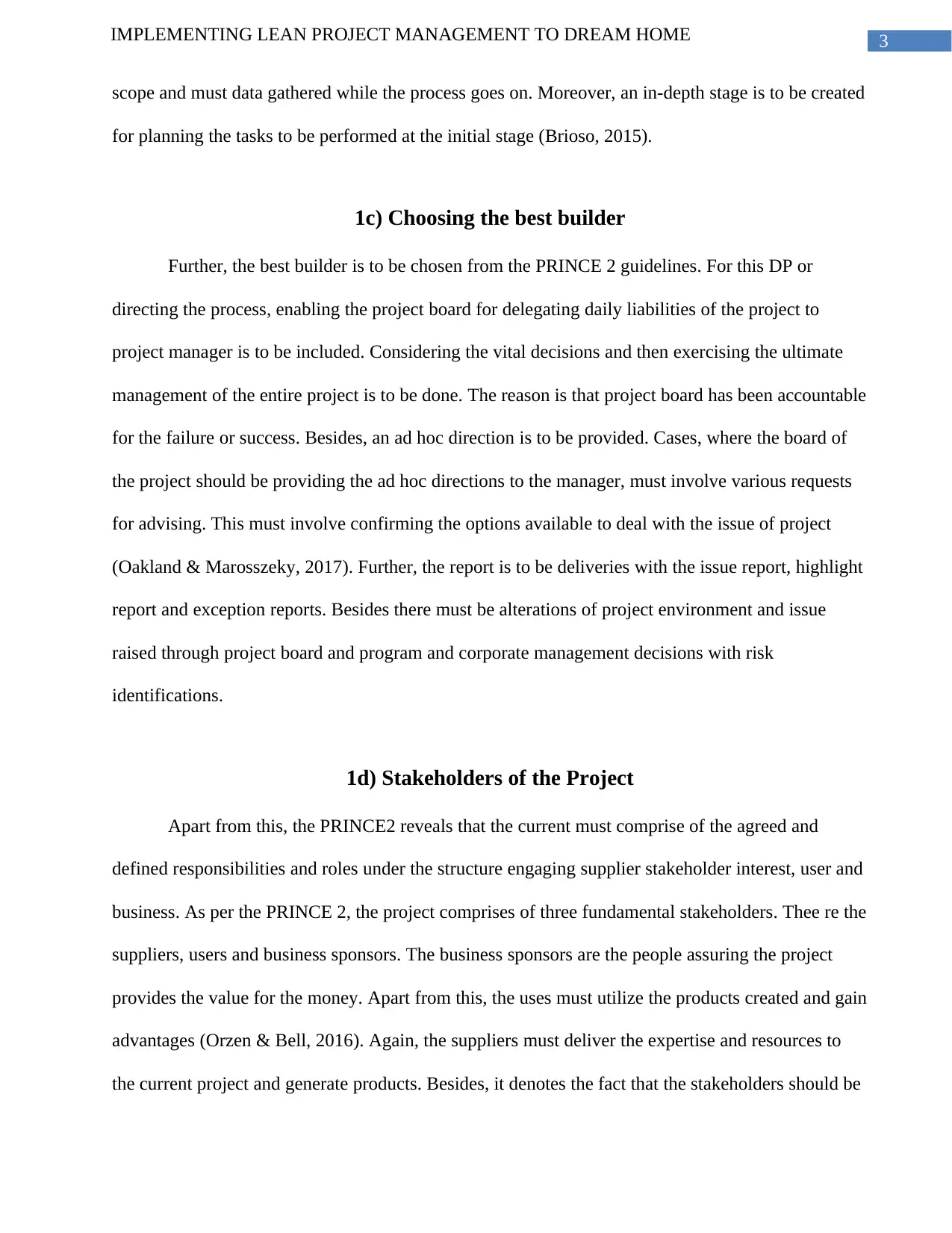
3IMPLEMENTING LEAN PROJECT MANAGEMENT TO DREAM HOME
scope and must data gathered while the process goes on. Moreover, an in-depth stage is to be created
for planning the tasks to be performed at the initial stage (Brioso, 2015).
1c) Choosing the best builder
Further, the best builder is to be chosen from the PRINCE 2 guidelines. For this DP or
directing the process, enabling the project board for delegating daily liabilities of the project to
project manager is to be included. Considering the vital decisions and then exercising the ultimate
management of the entire project is to be done. The reason is that project board has been accountable
for the failure or success. Besides, an ad hoc direction is to be provided. Cases, where the board of
the project should be providing the ad hoc directions to the manager, must involve various requests
for advising. This must involve confirming the options available to deal with the issue of project
(Oakland & Marosszeky, 2017). Further, the report is to be deliveries with the issue report, highlight
report and exception reports. Besides there must be alterations of project environment and issue
raised through project board and program and corporate management decisions with risk
identifications.
1d) Stakeholders of the Project
Apart from this, the PRINCE2 reveals that the current must comprise of the agreed and
defined responsibilities and roles under the structure engaging supplier stakeholder interest, user and
business. As per the PRINCE 2, the project comprises of three fundamental stakeholders. Thee re the
suppliers, users and business sponsors. The business sponsors are the people assuring the project
provides the value for the money. Apart from this, the uses must utilize the products created and gain
advantages (Orzen & Bell, 2016). Again, the suppliers must deliver the expertise and resources to
the current project and generate products. Besides, it denotes the fact that the stakeholders should be
scope and must data gathered while the process goes on. Moreover, an in-depth stage is to be created
for planning the tasks to be performed at the initial stage (Brioso, 2015).
1c) Choosing the best builder
Further, the best builder is to be chosen from the PRINCE 2 guidelines. For this DP or
directing the process, enabling the project board for delegating daily liabilities of the project to
project manager is to be included. Considering the vital decisions and then exercising the ultimate
management of the entire project is to be done. The reason is that project board has been accountable
for the failure or success. Besides, an ad hoc direction is to be provided. Cases, where the board of
the project should be providing the ad hoc directions to the manager, must involve various requests
for advising. This must involve confirming the options available to deal with the issue of project
(Oakland & Marosszeky, 2017). Further, the report is to be deliveries with the issue report, highlight
report and exception reports. Besides there must be alterations of project environment and issue
raised through project board and program and corporate management decisions with risk
identifications.
1d) Stakeholders of the Project
Apart from this, the PRINCE2 reveals that the current must comprise of the agreed and
defined responsibilities and roles under the structure engaging supplier stakeholder interest, user and
business. As per the PRINCE 2, the project comprises of three fundamental stakeholders. Thee re the
suppliers, users and business sponsors. The business sponsors are the people assuring the project
provides the value for the money. Apart from this, the uses must utilize the products created and gain
advantages (Orzen & Bell, 2016). Again, the suppliers must deliver the expertise and resources to
the current project and generate products. Besides, it denotes the fact that the stakeholders should be
Secure Best Marks with AI Grader
Need help grading? Try our AI Grader for instant feedback on your assignments.
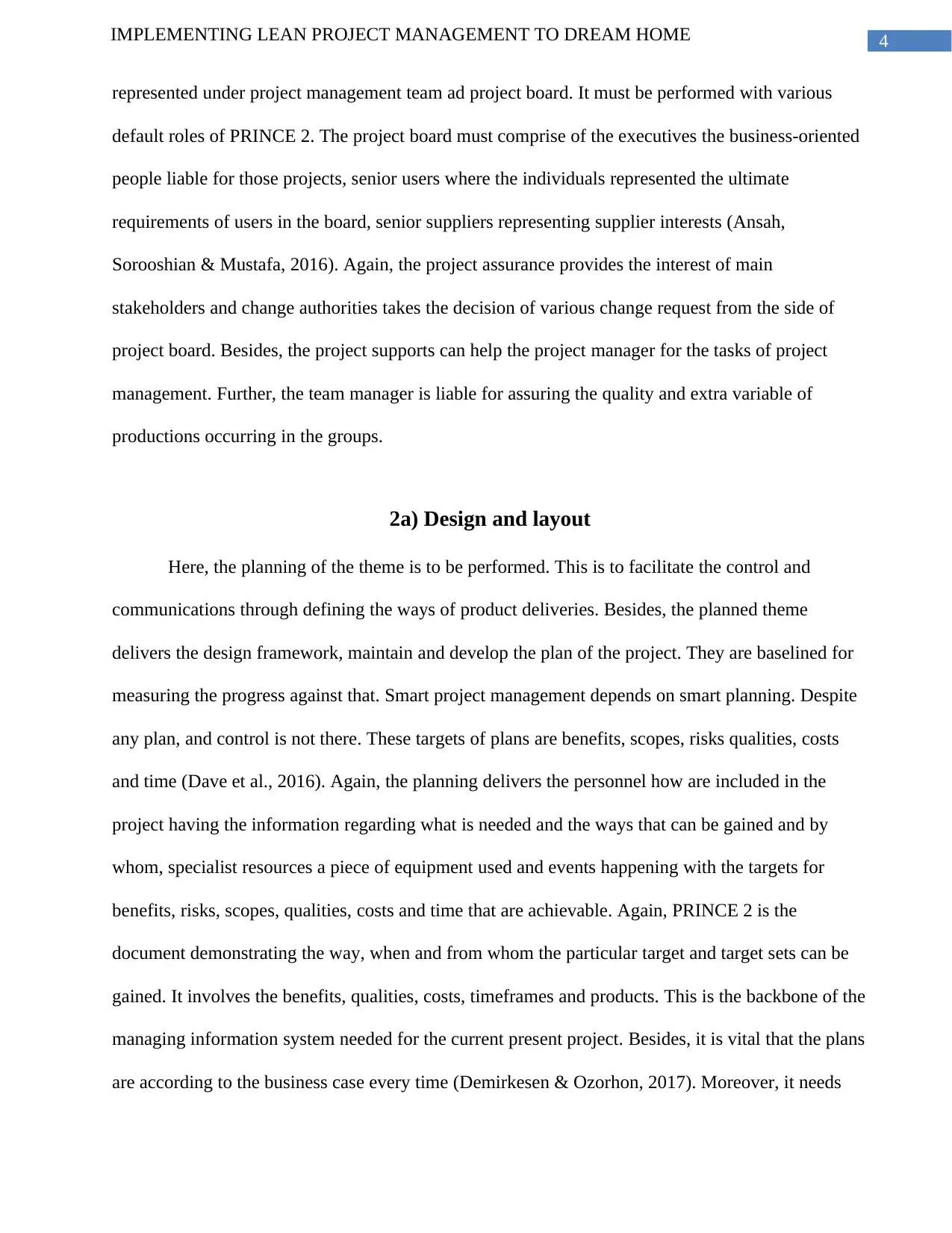
4IMPLEMENTING LEAN PROJECT MANAGEMENT TO DREAM HOME
represented under project management team ad project board. It must be performed with various
default roles of PRINCE 2. The project board must comprise of the executives the business-oriented
people liable for those projects, senior users where the individuals represented the ultimate
requirements of users in the board, senior suppliers representing supplier interests (Ansah,
Sorooshian & Mustafa, 2016). Again, the project assurance provides the interest of main
stakeholders and change authorities takes the decision of various change request from the side of
project board. Besides, the project supports can help the project manager for the tasks of project
management. Further, the team manager is liable for assuring the quality and extra variable of
productions occurring in the groups.
2a) Design and layout
Here, the planning of the theme is to be performed. This is to facilitate the control and
communications through defining the ways of product deliveries. Besides, the planned theme
delivers the design framework, maintain and develop the plan of the project. They are baselined for
measuring the progress against that. Smart project management depends on smart planning. Despite
any plan, and control is not there. These targets of plans are benefits, scopes, risks qualities, costs
and time (Dave et al., 2016). Again, the planning delivers the personnel how are included in the
project having the information regarding what is needed and the ways that can be gained and by
whom, specialist resources a piece of equipment used and events happening with the targets for
benefits, risks, scopes, qualities, costs and time that are achievable. Again, PRINCE 2 is the
document demonstrating the way, when and from whom the particular target and target sets can be
gained. It involves the benefits, qualities, costs, timeframes and products. This is the backbone of the
managing information system needed for the current present project. Besides, it is vital that the plans
are according to the business case every time (Demirkesen & Ozorhon, 2017). Moreover, it needs
represented under project management team ad project board. It must be performed with various
default roles of PRINCE 2. The project board must comprise of the executives the business-oriented
people liable for those projects, senior users where the individuals represented the ultimate
requirements of users in the board, senior suppliers representing supplier interests (Ansah,
Sorooshian & Mustafa, 2016). Again, the project assurance provides the interest of main
stakeholders and change authorities takes the decision of various change request from the side of
project board. Besides, the project supports can help the project manager for the tasks of project
management. Further, the team manager is liable for assuring the quality and extra variable of
productions occurring in the groups.
2a) Design and layout
Here, the planning of the theme is to be performed. This is to facilitate the control and
communications through defining the ways of product deliveries. Besides, the planned theme
delivers the design framework, maintain and develop the plan of the project. They are baselined for
measuring the progress against that. Smart project management depends on smart planning. Despite
any plan, and control is not there. These targets of plans are benefits, scopes, risks qualities, costs
and time (Dave et al., 2016). Again, the planning delivers the personnel how are included in the
project having the information regarding what is needed and the ways that can be gained and by
whom, specialist resources a piece of equipment used and events happening with the targets for
benefits, risks, scopes, qualities, costs and time that are achievable. Again, PRINCE 2 is the
document demonstrating the way, when and from whom the particular target and target sets can be
gained. It involves the benefits, qualities, costs, timeframes and products. This is the backbone of the
managing information system needed for the current present project. Besides, it is vital that the plans
are according to the business case every time (Demirkesen & Ozorhon, 2017). Moreover, it needs
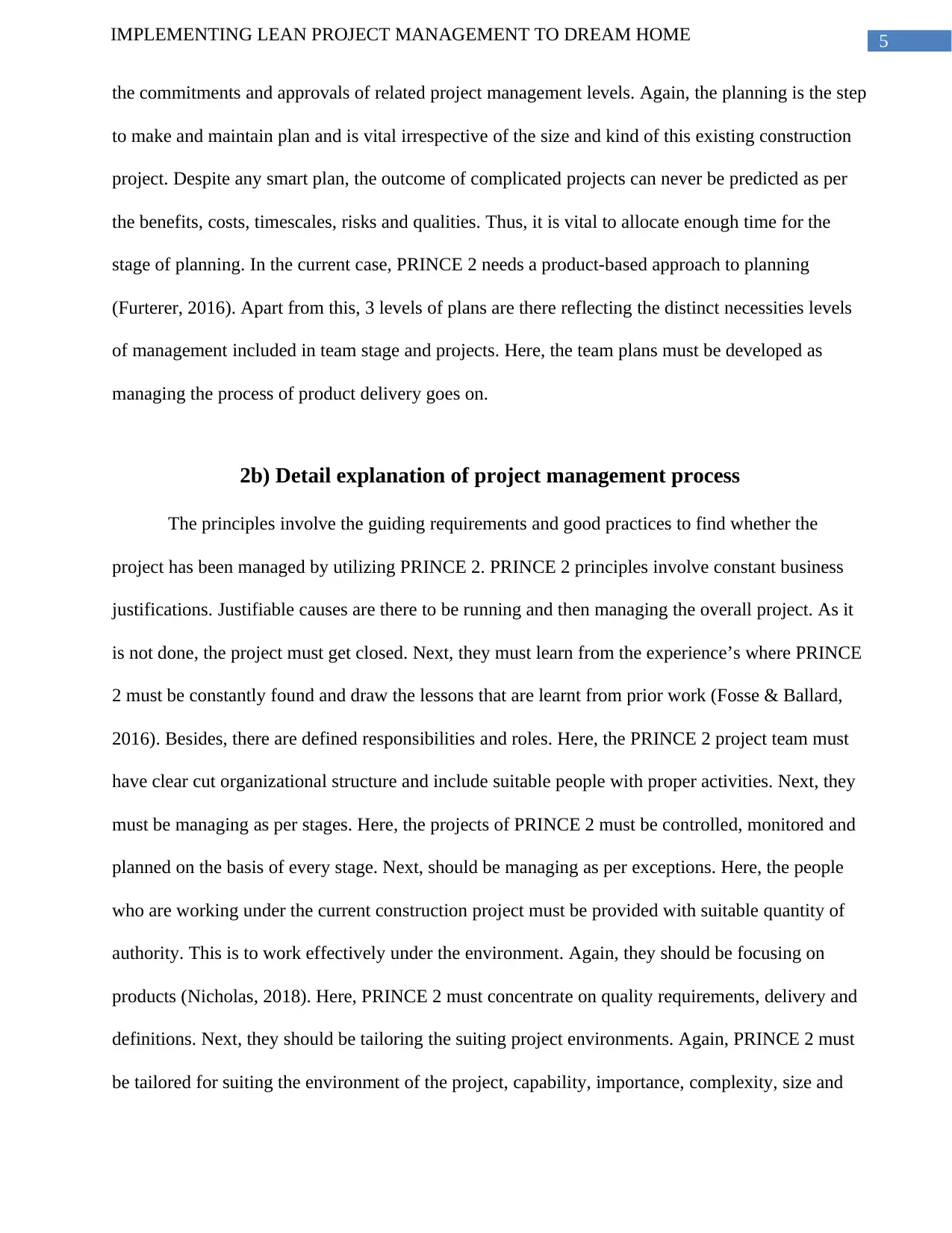
5IMPLEMENTING LEAN PROJECT MANAGEMENT TO DREAM HOME
the commitments and approvals of related project management levels. Again, the planning is the step
to make and maintain plan and is vital irrespective of the size and kind of this existing construction
project. Despite any smart plan, the outcome of complicated projects can never be predicted as per
the benefits, costs, timescales, risks and qualities. Thus, it is vital to allocate enough time for the
stage of planning. In the current case, PRINCE 2 needs a product-based approach to planning
(Furterer, 2016). Apart from this, 3 levels of plans are there reflecting the distinct necessities levels
of management included in team stage and projects. Here, the team plans must be developed as
managing the process of product delivery goes on.
2b) Detail explanation of project management process
The principles involve the guiding requirements and good practices to find whether the
project has been managed by utilizing PRINCE 2. PRINCE 2 principles involve constant business
justifications. Justifiable causes are there to be running and then managing the overall project. As it
is not done, the project must get closed. Next, they must learn from the experience’s where PRINCE
2 must be constantly found and draw the lessons that are learnt from prior work (Fosse & Ballard,
2016). Besides, there are defined responsibilities and roles. Here, the PRINCE 2 project team must
have clear cut organizational structure and include suitable people with proper activities. Next, they
must be managing as per stages. Here, the projects of PRINCE 2 must be controlled, monitored and
planned on the basis of every stage. Next, should be managing as per exceptions. Here, the people
who are working under the current construction project must be provided with suitable quantity of
authority. This is to work effectively under the environment. Again, they should be focusing on
products (Nicholas, 2018). Here, PRINCE 2 must concentrate on quality requirements, delivery and
definitions. Next, they should be tailoring the suiting project environments. Again, PRINCE 2 must
be tailored for suiting the environment of the project, capability, importance, complexity, size and
the commitments and approvals of related project management levels. Again, the planning is the step
to make and maintain plan and is vital irrespective of the size and kind of this existing construction
project. Despite any smart plan, the outcome of complicated projects can never be predicted as per
the benefits, costs, timescales, risks and qualities. Thus, it is vital to allocate enough time for the
stage of planning. In the current case, PRINCE 2 needs a product-based approach to planning
(Furterer, 2016). Apart from this, 3 levels of plans are there reflecting the distinct necessities levels
of management included in team stage and projects. Here, the team plans must be developed as
managing the process of product delivery goes on.
2b) Detail explanation of project management process
The principles involve the guiding requirements and good practices to find whether the
project has been managed by utilizing PRINCE 2. PRINCE 2 principles involve constant business
justifications. Justifiable causes are there to be running and then managing the overall project. As it
is not done, the project must get closed. Next, they must learn from the experience’s where PRINCE
2 must be constantly found and draw the lessons that are learnt from prior work (Fosse & Ballard,
2016). Besides, there are defined responsibilities and roles. Here, the PRINCE 2 project team must
have clear cut organizational structure and include suitable people with proper activities. Next, they
must be managing as per stages. Here, the projects of PRINCE 2 must be controlled, monitored and
planned on the basis of every stage. Next, should be managing as per exceptions. Here, the people
who are working under the current construction project must be provided with suitable quantity of
authority. This is to work effectively under the environment. Again, they should be focusing on
products (Nicholas, 2018). Here, PRINCE 2 must concentrate on quality requirements, delivery and
definitions. Next, they should be tailoring the suiting project environments. Again, PRINCE 2 must
be tailored for suiting the environment of the project, capability, importance, complexity, size and
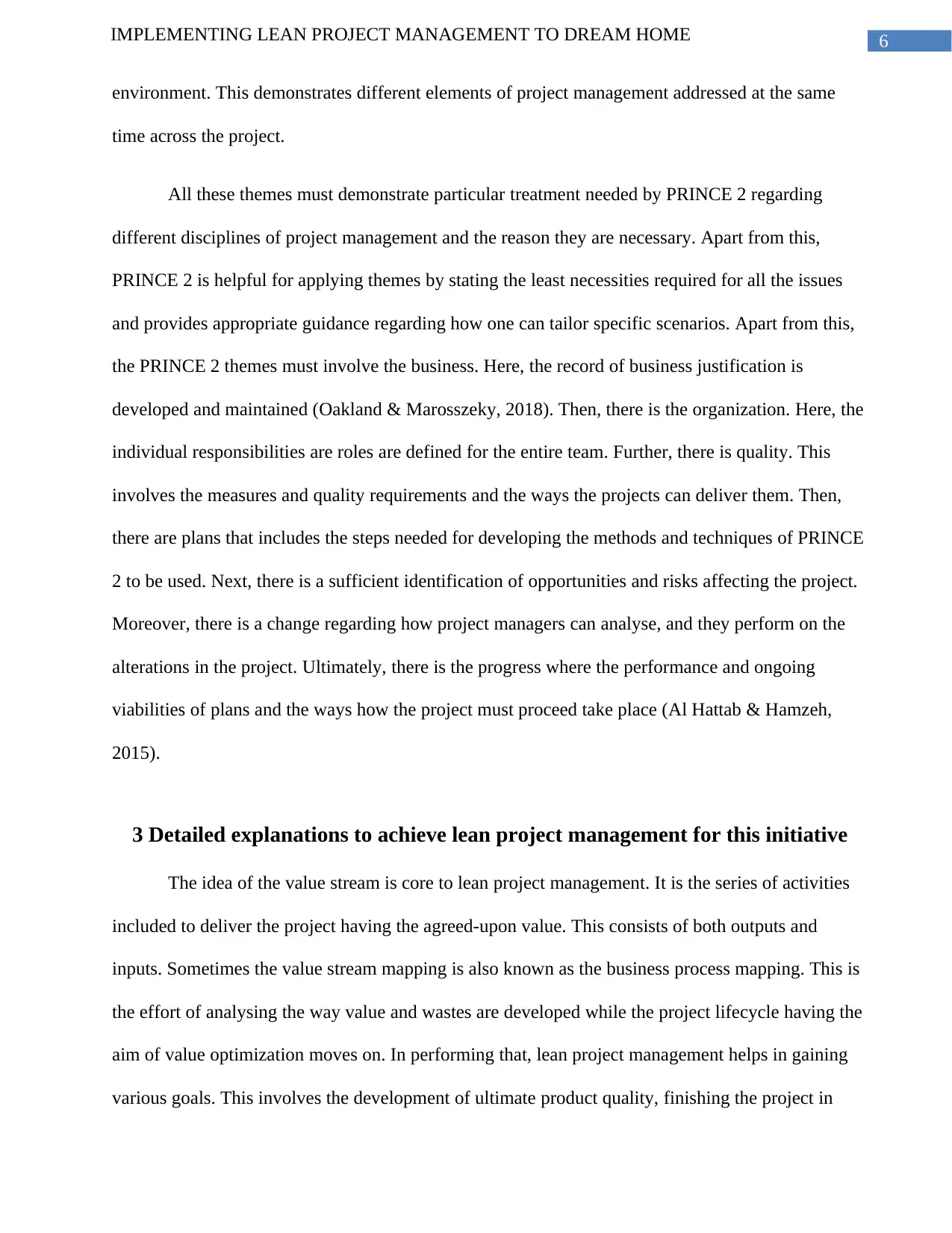
6IMPLEMENTING LEAN PROJECT MANAGEMENT TO DREAM HOME
environment. This demonstrates different elements of project management addressed at the same
time across the project.
All these themes must demonstrate particular treatment needed by PRINCE 2 regarding
different disciplines of project management and the reason they are necessary. Apart from this,
PRINCE 2 is helpful for applying themes by stating the least necessities required for all the issues
and provides appropriate guidance regarding how one can tailor specific scenarios. Apart from this,
the PRINCE 2 themes must involve the business. Here, the record of business justification is
developed and maintained (Oakland & Marosszeky, 2018). Then, there is the organization. Here, the
individual responsibilities are roles are defined for the entire team. Further, there is quality. This
involves the measures and quality requirements and the ways the projects can deliver them. Then,
there are plans that includes the steps needed for developing the methods and techniques of PRINCE
2 to be used. Next, there is a sufficient identification of opportunities and risks affecting the project.
Moreover, there is a change regarding how project managers can analyse, and they perform on the
alterations in the project. Ultimately, there is the progress where the performance and ongoing
viabilities of plans and the ways how the project must proceed take place (Al Hattab & Hamzeh,
2015).
3 Detailed explanations to achieve lean project management for this initiative
The idea of the value stream is core to lean project management. It is the series of activities
included to deliver the project having the agreed-upon value. This consists of both outputs and
inputs. Sometimes the value stream mapping is also known as the business process mapping. This is
the effort of analysing the way value and wastes are developed while the project lifecycle having the
aim of value optimization moves on. In performing that, lean project management helps in gaining
various goals. This involves the development of ultimate product quality, finishing the project in
environment. This demonstrates different elements of project management addressed at the same
time across the project.
All these themes must demonstrate particular treatment needed by PRINCE 2 regarding
different disciplines of project management and the reason they are necessary. Apart from this,
PRINCE 2 is helpful for applying themes by stating the least necessities required for all the issues
and provides appropriate guidance regarding how one can tailor specific scenarios. Apart from this,
the PRINCE 2 themes must involve the business. Here, the record of business justification is
developed and maintained (Oakland & Marosszeky, 2018). Then, there is the organization. Here, the
individual responsibilities are roles are defined for the entire team. Further, there is quality. This
involves the measures and quality requirements and the ways the projects can deliver them. Then,
there are plans that includes the steps needed for developing the methods and techniques of PRINCE
2 to be used. Next, there is a sufficient identification of opportunities and risks affecting the project.
Moreover, there is a change regarding how project managers can analyse, and they perform on the
alterations in the project. Ultimately, there is the progress where the performance and ongoing
viabilities of plans and the ways how the project must proceed take place (Al Hattab & Hamzeh,
2015).
3 Detailed explanations to achieve lean project management for this initiative
The idea of the value stream is core to lean project management. It is the series of activities
included to deliver the project having the agreed-upon value. This consists of both outputs and
inputs. Sometimes the value stream mapping is also known as the business process mapping. This is
the effort of analysing the way value and wastes are developed while the project lifecycle having the
aim of value optimization moves on. In performing that, lean project management helps in gaining
various goals. This involves the development of ultimate product quality, finishing the project in
Paraphrase This Document
Need a fresh take? Get an instant paraphrase of this document with our AI Paraphraser
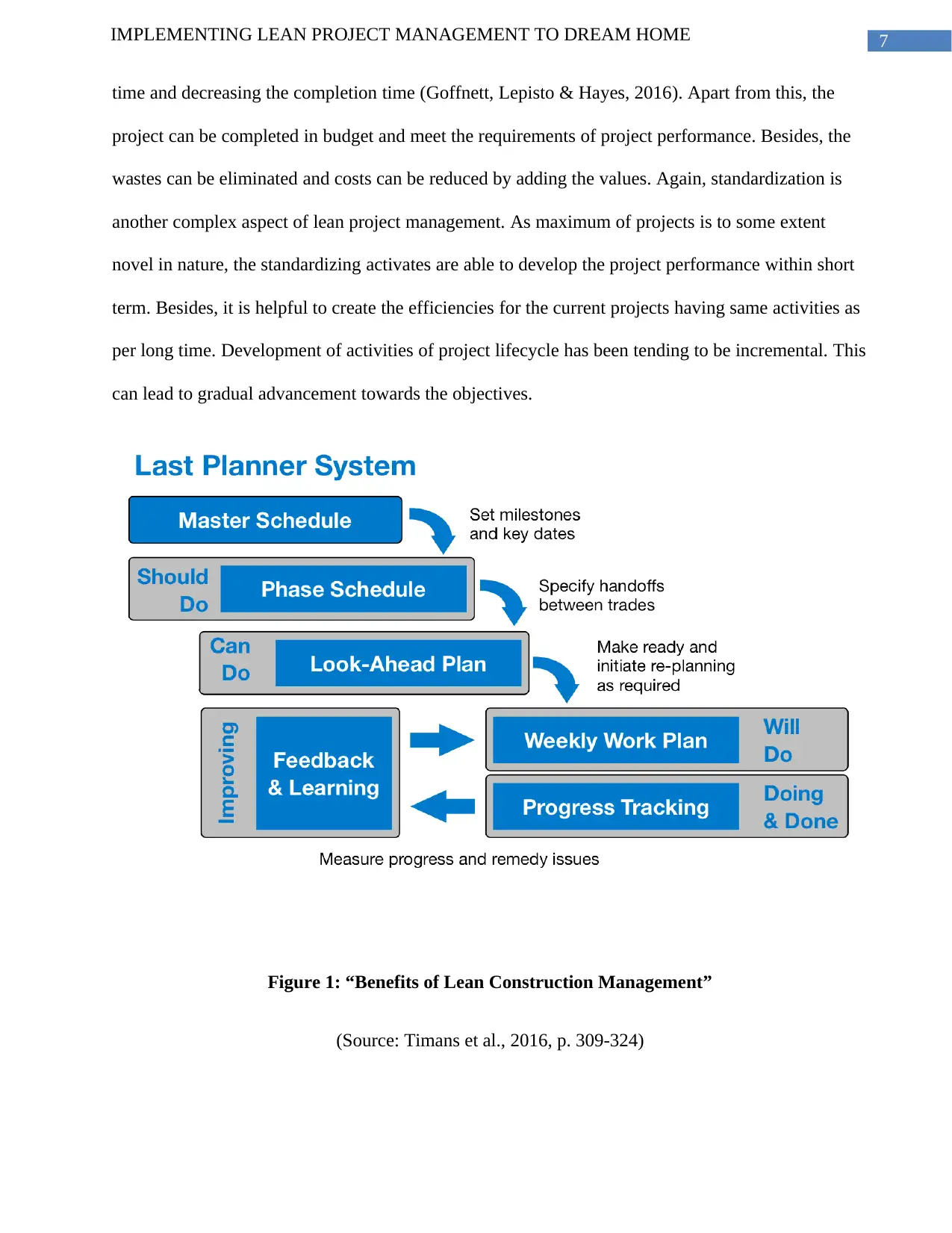
7IMPLEMENTING LEAN PROJECT MANAGEMENT TO DREAM HOME
time and decreasing the completion time (Goffnett, Lepisto & Hayes, 2016). Apart from this, the
project can be completed in budget and meet the requirements of project performance. Besides, the
wastes can be eliminated and costs can be reduced by adding the values. Again, standardization is
another complex aspect of lean project management. As maximum of projects is to some extent
novel in nature, the standardizing activates are able to develop the project performance within short
term. Besides, it is helpful to create the efficiencies for the current projects having same activities as
per long time. Development of activities of project lifecycle has been tending to be incremental. This
can lead to gradual advancement towards the objectives.
Figure 1: “Benefits of Lean Construction Management”
(Source: Timans et al., 2016, p. 309-324)
time and decreasing the completion time (Goffnett, Lepisto & Hayes, 2016). Apart from this, the
project can be completed in budget and meet the requirements of project performance. Besides, the
wastes can be eliminated and costs can be reduced by adding the values. Again, standardization is
another complex aspect of lean project management. As maximum of projects is to some extent
novel in nature, the standardizing activates are able to develop the project performance within short
term. Besides, it is helpful to create the efficiencies for the current projects having same activities as
per long time. Development of activities of project lifecycle has been tending to be incremental. This
can lead to gradual advancement towards the objectives.
Figure 1: “Benefits of Lean Construction Management”
(Source: Timans et al., 2016, p. 309-324)
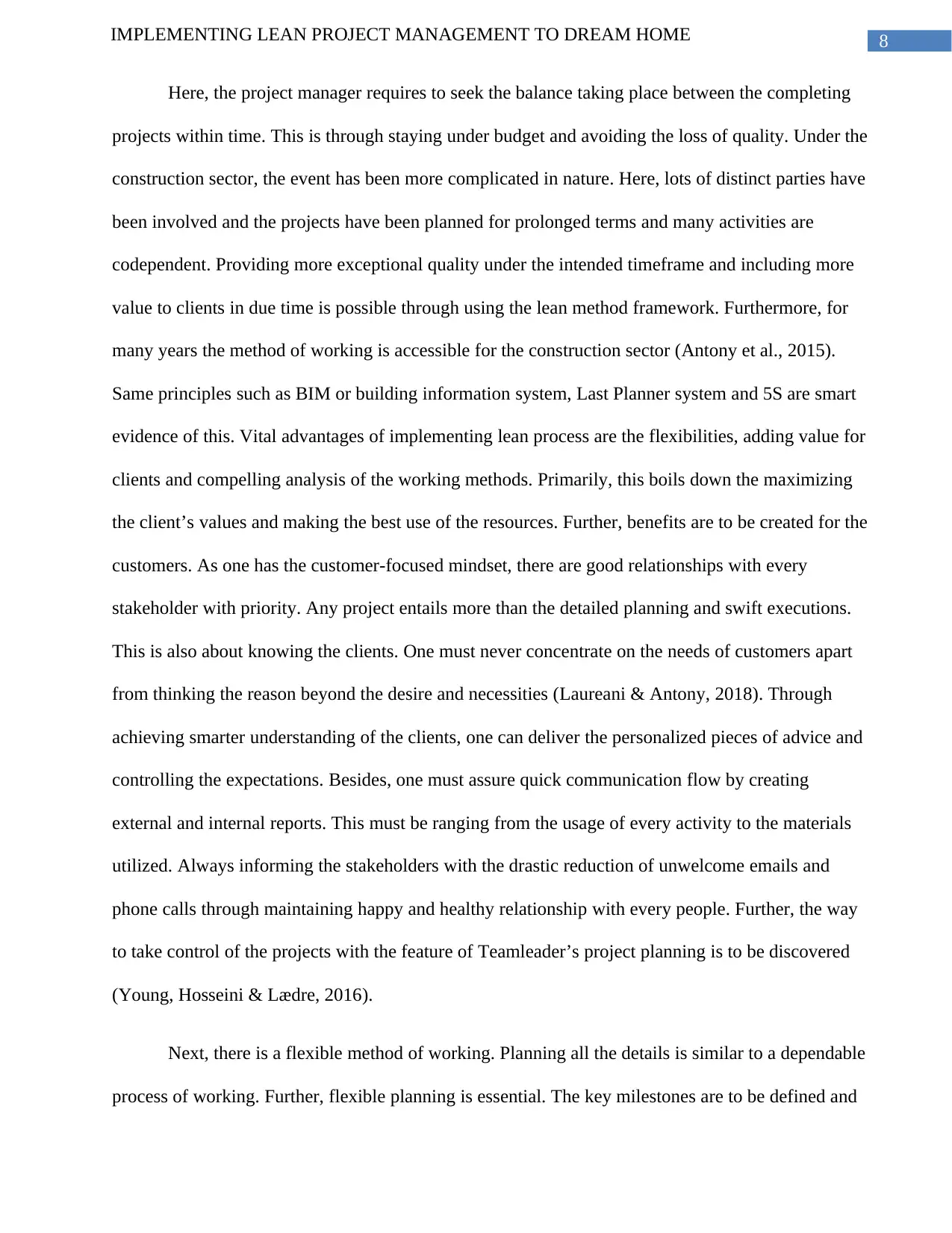
8IMPLEMENTING LEAN PROJECT MANAGEMENT TO DREAM HOME
Here, the project manager requires to seek the balance taking place between the completing
projects within time. This is through staying under budget and avoiding the loss of quality. Under the
construction sector, the event has been more complicated in nature. Here, lots of distinct parties have
been involved and the projects have been planned for prolonged terms and many activities are
codependent. Providing more exceptional quality under the intended timeframe and including more
value to clients in due time is possible through using the lean method framework. Furthermore, for
many years the method of working is accessible for the construction sector (Antony et al., 2015).
Same principles such as BIM or building information system, Last Planner system and 5S are smart
evidence of this. Vital advantages of implementing lean process are the flexibilities, adding value for
clients and compelling analysis of the working methods. Primarily, this boils down the maximizing
the client’s values and making the best use of the resources. Further, benefits are to be created for the
customers. As one has the customer-focused mindset, there are good relationships with every
stakeholder with priority. Any project entails more than the detailed planning and swift executions.
This is also about knowing the clients. One must never concentrate on the needs of customers apart
from thinking the reason beyond the desire and necessities (Laureani & Antony, 2018). Through
achieving smarter understanding of the clients, one can deliver the personalized pieces of advice and
controlling the expectations. Besides, one must assure quick communication flow by creating
external and internal reports. This must be ranging from the usage of every activity to the materials
utilized. Always informing the stakeholders with the drastic reduction of unwelcome emails and
phone calls through maintaining happy and healthy relationship with every people. Further, the way
to take control of the projects with the feature of Teamleader’s project planning is to be discovered
(Young, Hosseini & Lædre, 2016).
Next, there is a flexible method of working. Planning all the details is similar to a dependable
process of working. Further, flexible planning is essential. The key milestones are to be defined and
Here, the project manager requires to seek the balance taking place between the completing
projects within time. This is through staying under budget and avoiding the loss of quality. Under the
construction sector, the event has been more complicated in nature. Here, lots of distinct parties have
been involved and the projects have been planned for prolonged terms and many activities are
codependent. Providing more exceptional quality under the intended timeframe and including more
value to clients in due time is possible through using the lean method framework. Furthermore, for
many years the method of working is accessible for the construction sector (Antony et al., 2015).
Same principles such as BIM or building information system, Last Planner system and 5S are smart
evidence of this. Vital advantages of implementing lean process are the flexibilities, adding value for
clients and compelling analysis of the working methods. Primarily, this boils down the maximizing
the client’s values and making the best use of the resources. Further, benefits are to be created for the
customers. As one has the customer-focused mindset, there are good relationships with every
stakeholder with priority. Any project entails more than the detailed planning and swift executions.
This is also about knowing the clients. One must never concentrate on the needs of customers apart
from thinking the reason beyond the desire and necessities (Laureani & Antony, 2018). Through
achieving smarter understanding of the clients, one can deliver the personalized pieces of advice and
controlling the expectations. Besides, one must assure quick communication flow by creating
external and internal reports. This must be ranging from the usage of every activity to the materials
utilized. Always informing the stakeholders with the drastic reduction of unwelcome emails and
phone calls through maintaining happy and healthy relationship with every people. Further, the way
to take control of the projects with the feature of Teamleader’s project planning is to be discovered
(Young, Hosseini & Lædre, 2016).
Next, there is a flexible method of working. Planning all the details is similar to a dependable
process of working. Further, flexible planning is essential. The key milestones are to be defined and
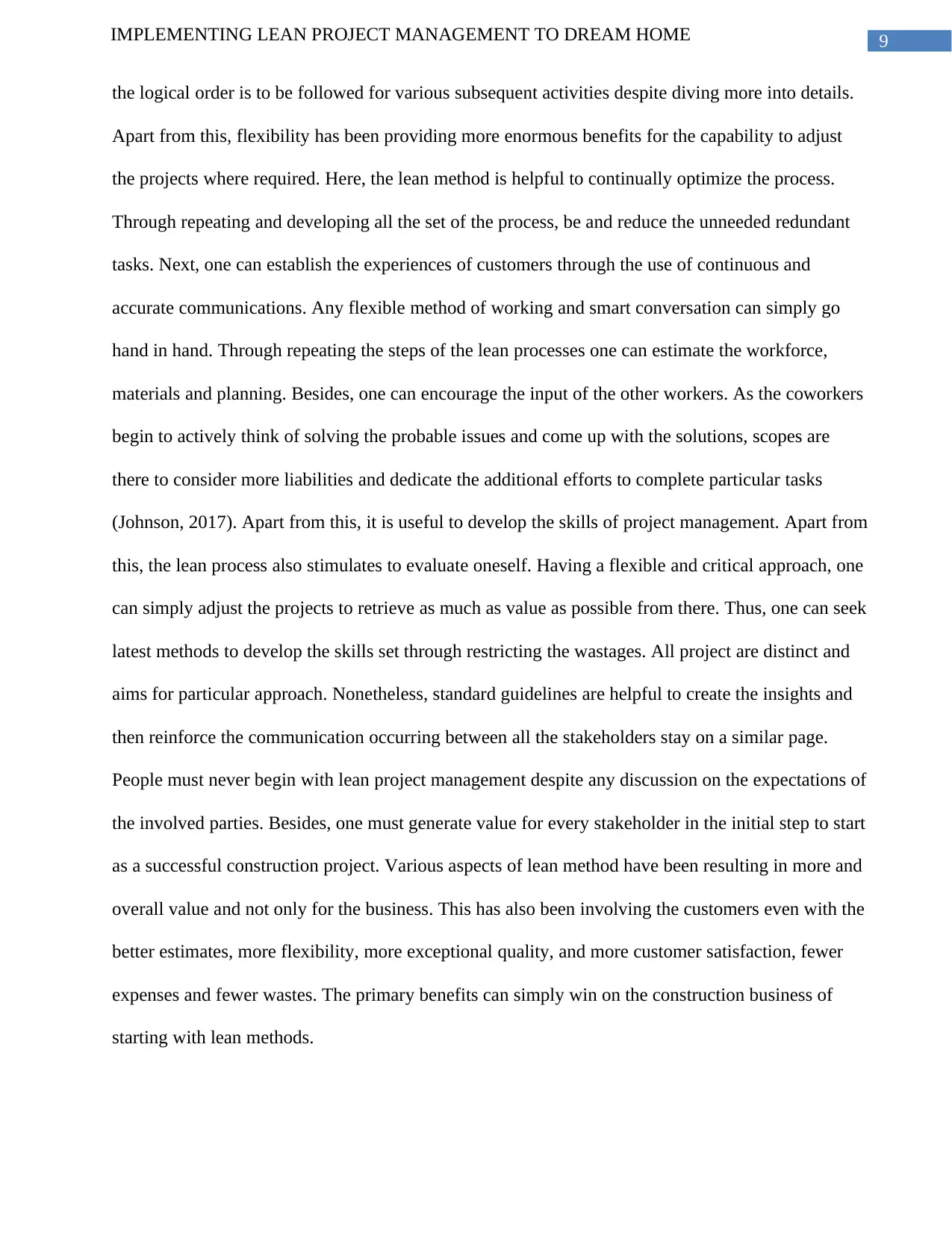
9IMPLEMENTING LEAN PROJECT MANAGEMENT TO DREAM HOME
the logical order is to be followed for various subsequent activities despite diving more into details.
Apart from this, flexibility has been providing more enormous benefits for the capability to adjust
the projects where required. Here, the lean method is helpful to continually optimize the process.
Through repeating and developing all the set of the process, be and reduce the unneeded redundant
tasks. Next, one can establish the experiences of customers through the use of continuous and
accurate communications. Any flexible method of working and smart conversation can simply go
hand in hand. Through repeating the steps of the lean processes one can estimate the workforce,
materials and planning. Besides, one can encourage the input of the other workers. As the coworkers
begin to actively think of solving the probable issues and come up with the solutions, scopes are
there to consider more liabilities and dedicate the additional efforts to complete particular tasks
(Johnson, 2017). Apart from this, it is useful to develop the skills of project management. Apart from
this, the lean process also stimulates to evaluate oneself. Having a flexible and critical approach, one
can simply adjust the projects to retrieve as much as value as possible from there. Thus, one can seek
latest methods to develop the skills set through restricting the wastages. All project are distinct and
aims for particular approach. Nonetheless, standard guidelines are helpful to create the insights and
then reinforce the communication occurring between all the stakeholders stay on a similar page.
People must never begin with lean project management despite any discussion on the expectations of
the involved parties. Besides, one must generate value for every stakeholder in the initial step to start
as a successful construction project. Various aspects of lean method have been resulting in more and
overall value and not only for the business. This has also been involving the customers even with the
better estimates, more flexibility, more exceptional quality, and more customer satisfaction, fewer
expenses and fewer wastes. The primary benefits can simply win on the construction business of
starting with lean methods.
the logical order is to be followed for various subsequent activities despite diving more into details.
Apart from this, flexibility has been providing more enormous benefits for the capability to adjust
the projects where required. Here, the lean method is helpful to continually optimize the process.
Through repeating and developing all the set of the process, be and reduce the unneeded redundant
tasks. Next, one can establish the experiences of customers through the use of continuous and
accurate communications. Any flexible method of working and smart conversation can simply go
hand in hand. Through repeating the steps of the lean processes one can estimate the workforce,
materials and planning. Besides, one can encourage the input of the other workers. As the coworkers
begin to actively think of solving the probable issues and come up with the solutions, scopes are
there to consider more liabilities and dedicate the additional efforts to complete particular tasks
(Johnson, 2017). Apart from this, it is useful to develop the skills of project management. Apart from
this, the lean process also stimulates to evaluate oneself. Having a flexible and critical approach, one
can simply adjust the projects to retrieve as much as value as possible from there. Thus, one can seek
latest methods to develop the skills set through restricting the wastages. All project are distinct and
aims for particular approach. Nonetheless, standard guidelines are helpful to create the insights and
then reinforce the communication occurring between all the stakeholders stay on a similar page.
People must never begin with lean project management despite any discussion on the expectations of
the involved parties. Besides, one must generate value for every stakeholder in the initial step to start
as a successful construction project. Various aspects of lean method have been resulting in more and
overall value and not only for the business. This has also been involving the customers even with the
better estimates, more flexibility, more exceptional quality, and more customer satisfaction, fewer
expenses and fewer wastes. The primary benefits can simply win on the construction business of
starting with lean methods.
Secure Best Marks with AI Grader
Need help grading? Try our AI Grader for instant feedback on your assignments.
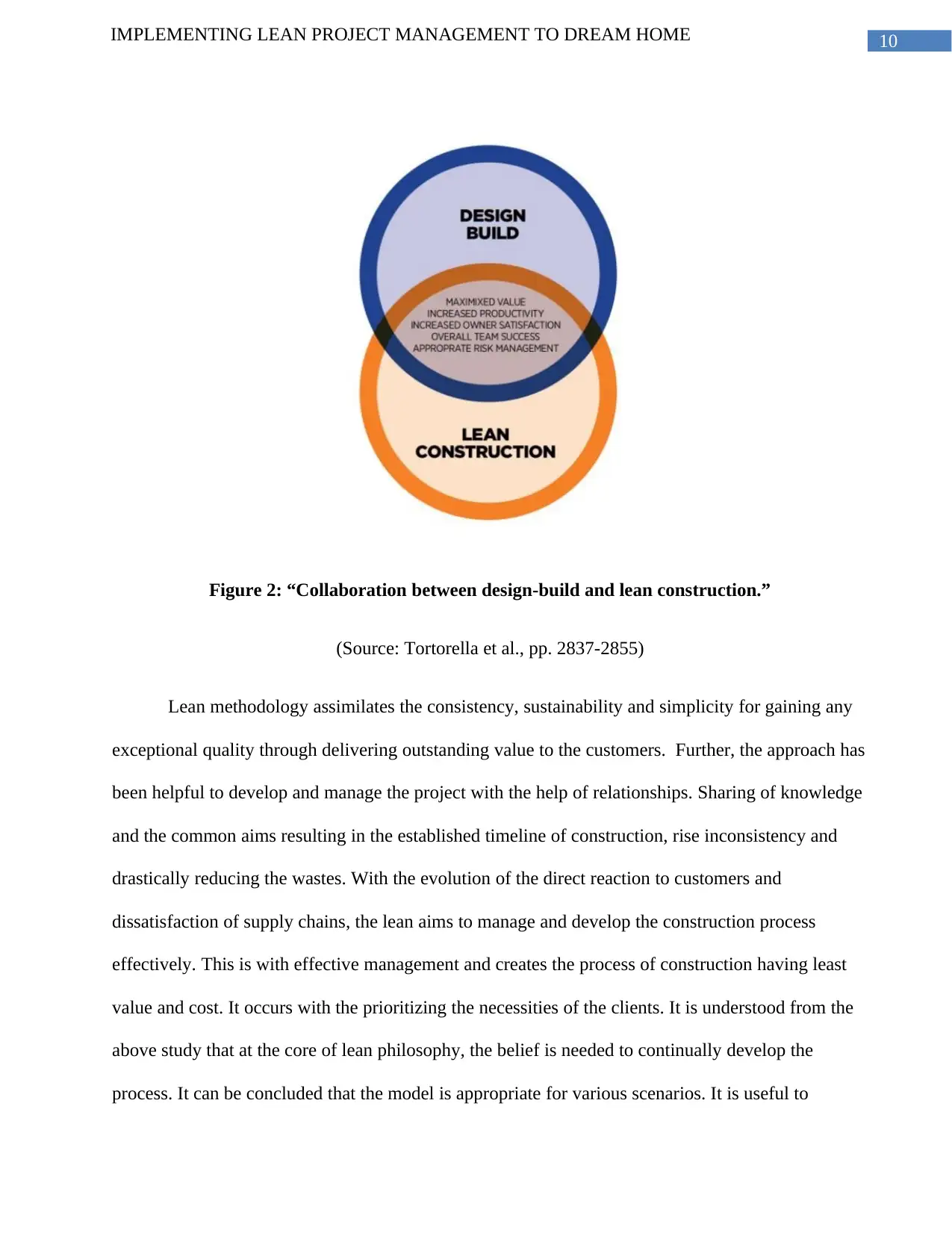
10IMPLEMENTING LEAN PROJECT MANAGEMENT TO DREAM HOME
Figure 2: “Collaboration between design-build and lean construction.”
(Source: Tortorella et al., pp. 2837-2855)
Lean methodology assimilates the consistency, sustainability and simplicity for gaining any
exceptional quality through delivering outstanding value to the customers. Further, the approach has
been helpful to develop and manage the project with the help of relationships. Sharing of knowledge
and the common aims resulting in the established timeline of construction, rise inconsistency and
drastically reducing the wastes. With the evolution of the direct reaction to customers and
dissatisfaction of supply chains, the lean aims to manage and develop the construction process
effectively. This is with effective management and creates the process of construction having least
value and cost. It occurs with the prioritizing the necessities of the clients. It is understood from the
above study that at the core of lean philosophy, the belief is needed to continually develop the
process. It can be concluded that the model is appropriate for various scenarios. It is useful to
Figure 2: “Collaboration between design-build and lean construction.”
(Source: Tortorella et al., pp. 2837-2855)
Lean methodology assimilates the consistency, sustainability and simplicity for gaining any
exceptional quality through delivering outstanding value to the customers. Further, the approach has
been helpful to develop and manage the project with the help of relationships. Sharing of knowledge
and the common aims resulting in the established timeline of construction, rise inconsistency and
drastically reducing the wastes. With the evolution of the direct reaction to customers and
dissatisfaction of supply chains, the lean aims to manage and develop the construction process
effectively. This is with effective management and creates the process of construction having least
value and cost. It occurs with the prioritizing the necessities of the clients. It is understood from the
above study that at the core of lean philosophy, the belief is needed to continually develop the
process. It can be concluded that the model is appropriate for various scenarios. It is useful to
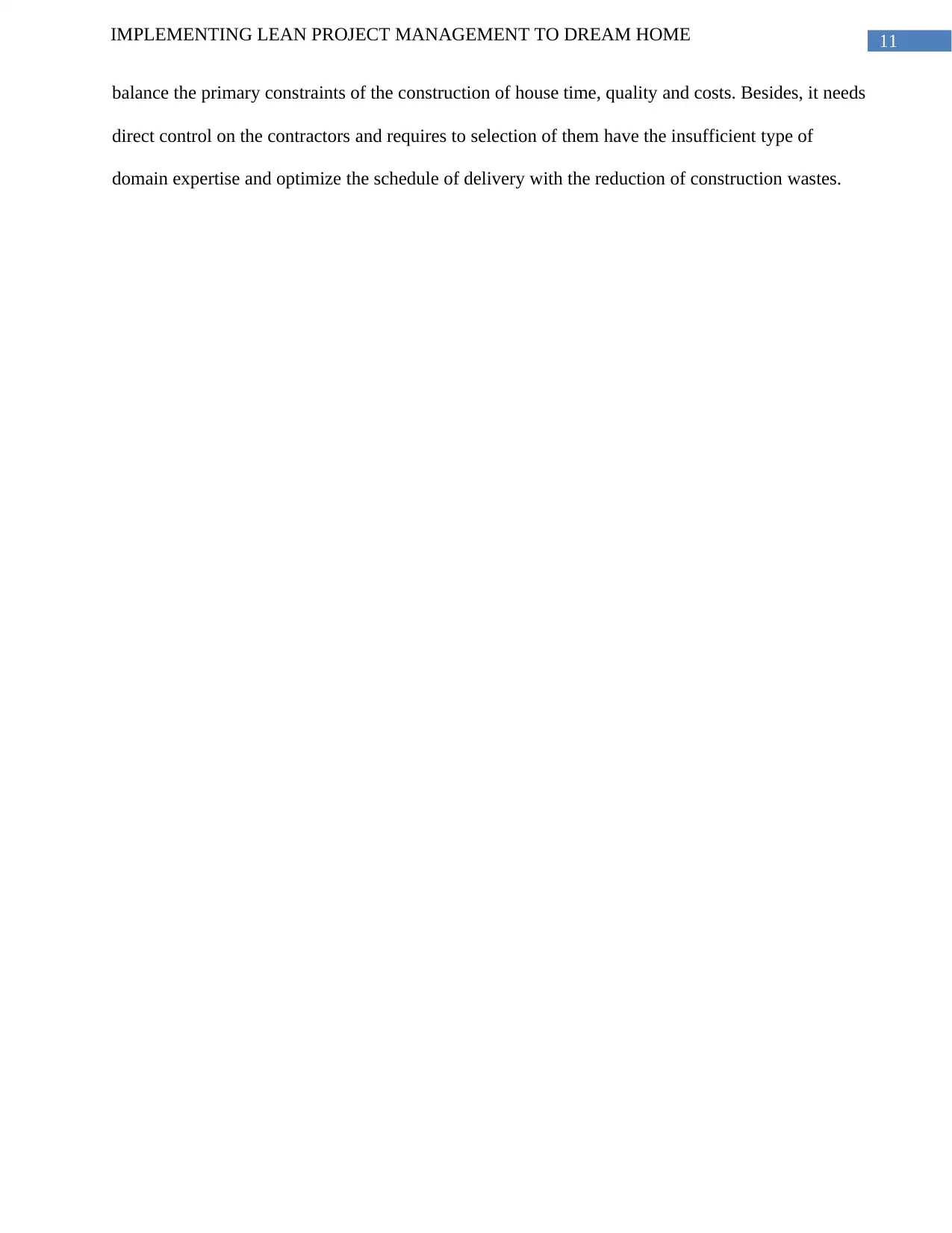
11IMPLEMENTING LEAN PROJECT MANAGEMENT TO DREAM HOME
balance the primary constraints of the construction of house time, quality and costs. Besides, it needs
direct control on the contractors and requires to selection of them have the insufficient type of
domain expertise and optimize the schedule of delivery with the reduction of construction wastes.
balance the primary constraints of the construction of house time, quality and costs. Besides, it needs
direct control on the contractors and requires to selection of them have the insufficient type of
domain expertise and optimize the schedule of delivery with the reduction of construction wastes.
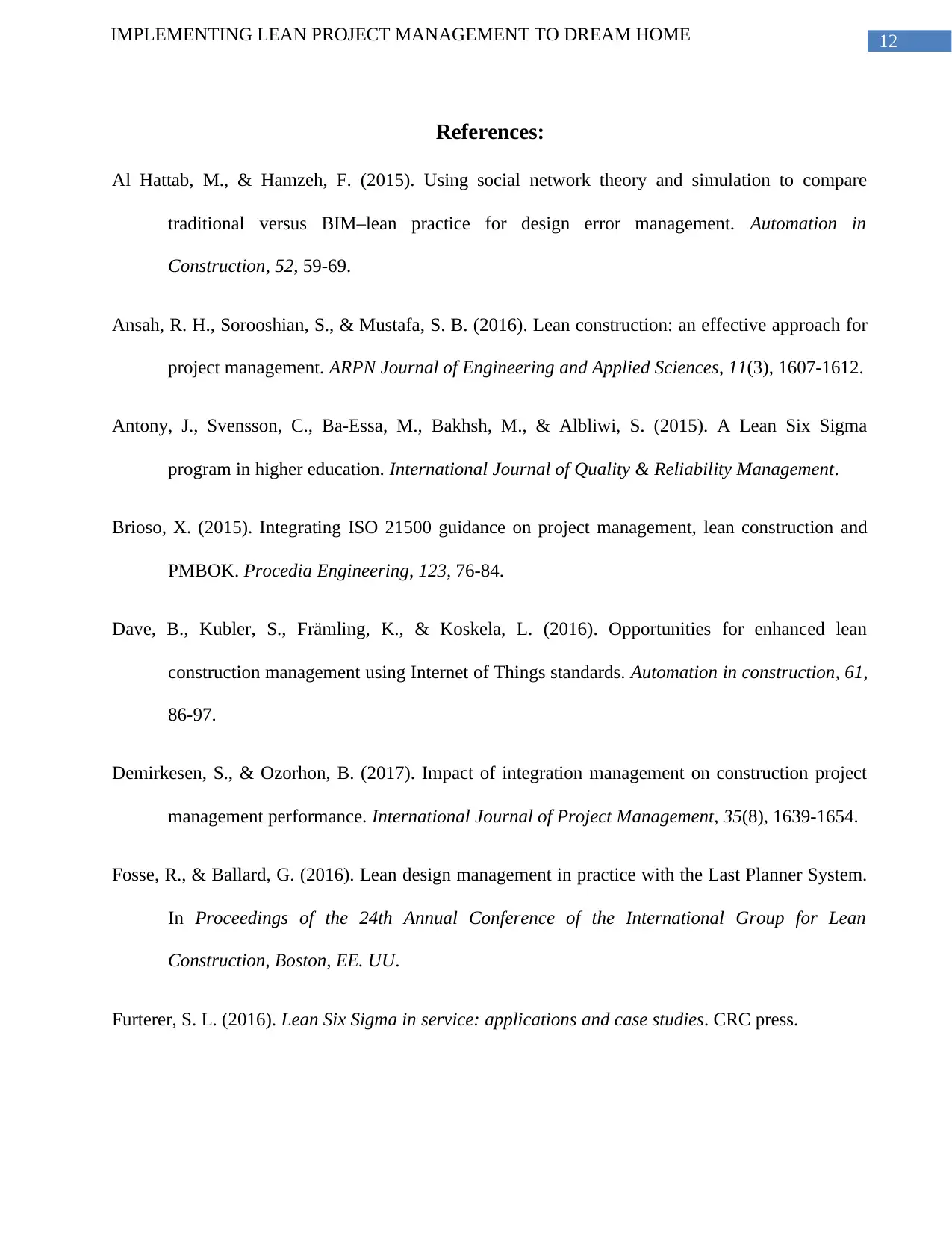
12IMPLEMENTING LEAN PROJECT MANAGEMENT TO DREAM HOME
References:
Al Hattab, M., & Hamzeh, F. (2015). Using social network theory and simulation to compare
traditional versus BIM–lean practice for design error management. Automation in
Construction, 52, 59-69.
Ansah, R. H., Sorooshian, S., & Mustafa, S. B. (2016). Lean construction: an effective approach for
project management. ARPN Journal of Engineering and Applied Sciences, 11(3), 1607-1612.
Antony, J., Svensson, C., Ba-Essa, M., Bakhsh, M., & Albliwi, S. (2015). A Lean Six Sigma
program in higher education. International Journal of Quality & Reliability Management.
Brioso, X. (2015). Integrating ISO 21500 guidance on project management, lean construction and
PMBOK. Procedia Engineering, 123, 76-84.
Dave, B., Kubler, S., Främling, K., & Koskela, L. (2016). Opportunities for enhanced lean
construction management using Internet of Things standards. Automation in construction, 61,
86-97.
Demirkesen, S., & Ozorhon, B. (2017). Impact of integration management on construction project
management performance. International Journal of Project Management, 35(8), 1639-1654.
Fosse, R., & Ballard, G. (2016). Lean design management in practice with the Last Planner System.
In Proceedings of the 24th Annual Conference of the International Group for Lean
Construction, Boston, EE. UU.
Furterer, S. L. (2016). Lean Six Sigma in service: applications and case studies. CRC press.
References:
Al Hattab, M., & Hamzeh, F. (2015). Using social network theory and simulation to compare
traditional versus BIM–lean practice for design error management. Automation in
Construction, 52, 59-69.
Ansah, R. H., Sorooshian, S., & Mustafa, S. B. (2016). Lean construction: an effective approach for
project management. ARPN Journal of Engineering and Applied Sciences, 11(3), 1607-1612.
Antony, J., Svensson, C., Ba-Essa, M., Bakhsh, M., & Albliwi, S. (2015). A Lean Six Sigma
program in higher education. International Journal of Quality & Reliability Management.
Brioso, X. (2015). Integrating ISO 21500 guidance on project management, lean construction and
PMBOK. Procedia Engineering, 123, 76-84.
Dave, B., Kubler, S., Främling, K., & Koskela, L. (2016). Opportunities for enhanced lean
construction management using Internet of Things standards. Automation in construction, 61,
86-97.
Demirkesen, S., & Ozorhon, B. (2017). Impact of integration management on construction project
management performance. International Journal of Project Management, 35(8), 1639-1654.
Fosse, R., & Ballard, G. (2016). Lean design management in practice with the Last Planner System.
In Proceedings of the 24th Annual Conference of the International Group for Lean
Construction, Boston, EE. UU.
Furterer, S. L. (2016). Lean Six Sigma in service: applications and case studies. CRC press.
Paraphrase This Document
Need a fresh take? Get an instant paraphrase of this document with our AI Paraphraser
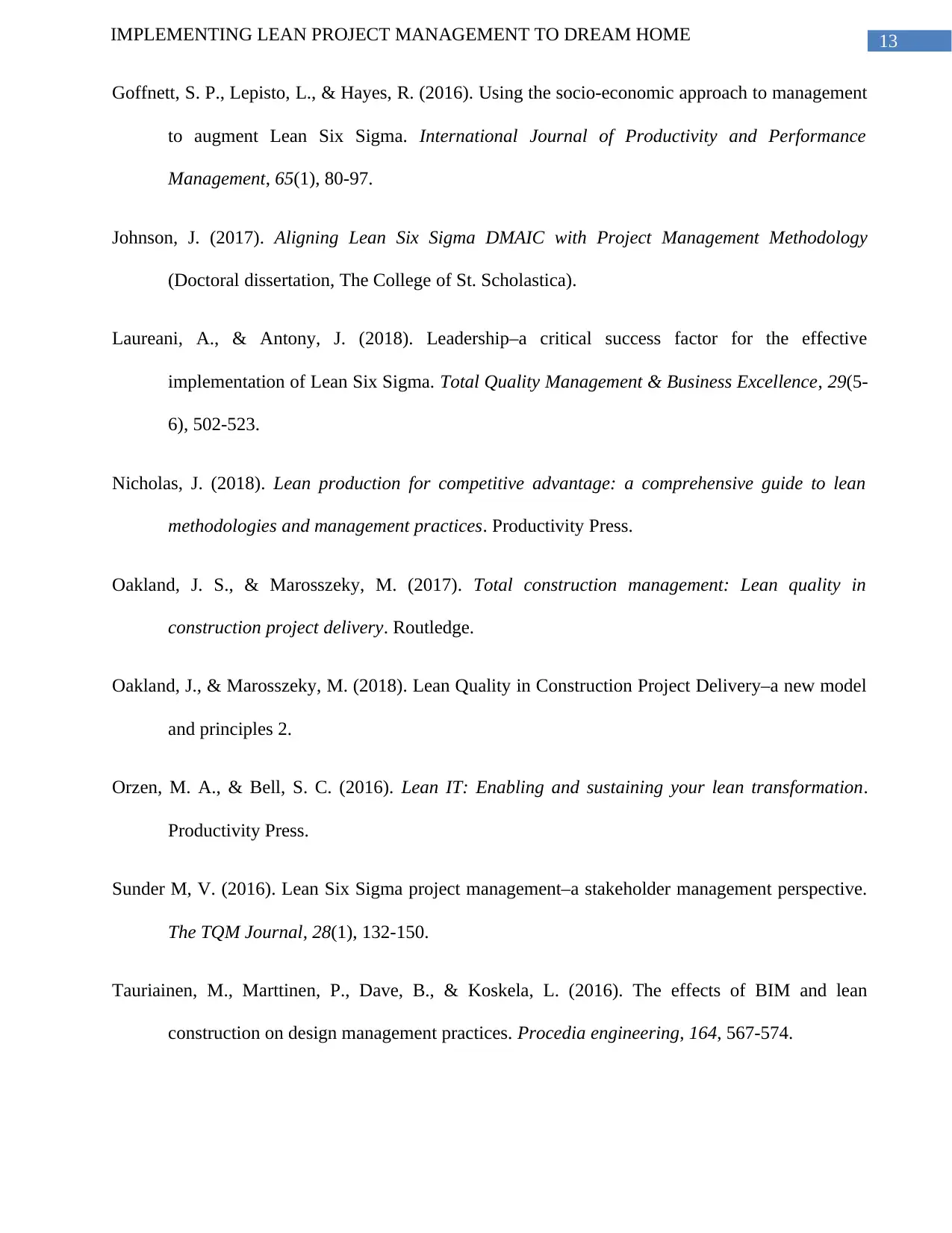
13IMPLEMENTING LEAN PROJECT MANAGEMENT TO DREAM HOME
Goffnett, S. P., Lepisto, L., & Hayes, R. (2016). Using the socio-economic approach to management
to augment Lean Six Sigma. International Journal of Productivity and Performance
Management, 65(1), 80-97.
Johnson, J. (2017). Aligning Lean Six Sigma DMAIC with Project Management Methodology
(Doctoral dissertation, The College of St. Scholastica).
Laureani, A., & Antony, J. (2018). Leadership–a critical success factor for the effective
implementation of Lean Six Sigma. Total Quality Management & Business Excellence, 29(5-
6), 502-523.
Nicholas, J. (2018). Lean production for competitive advantage: a comprehensive guide to lean
methodologies and management practices. Productivity Press.
Oakland, J. S., & Marosszeky, M. (2017). Total construction management: Lean quality in
construction project delivery. Routledge.
Oakland, J., & Marosszeky, M. (2018). Lean Quality in Construction Project Delivery–a new model
and principles 2.
Orzen, M. A., & Bell, S. C. (2016). Lean IT: Enabling and sustaining your lean transformation.
Productivity Press.
Sunder M, V. (2016). Lean Six Sigma project management–a stakeholder management perspective.
The TQM Journal, 28(1), 132-150.
Tauriainen, M., Marttinen, P., Dave, B., & Koskela, L. (2016). The effects of BIM and lean
construction on design management practices. Procedia engineering, 164, 567-574.
Goffnett, S. P., Lepisto, L., & Hayes, R. (2016). Using the socio-economic approach to management
to augment Lean Six Sigma. International Journal of Productivity and Performance
Management, 65(1), 80-97.
Johnson, J. (2017). Aligning Lean Six Sigma DMAIC with Project Management Methodology
(Doctoral dissertation, The College of St. Scholastica).
Laureani, A., & Antony, J. (2018). Leadership–a critical success factor for the effective
implementation of Lean Six Sigma. Total Quality Management & Business Excellence, 29(5-
6), 502-523.
Nicholas, J. (2018). Lean production for competitive advantage: a comprehensive guide to lean
methodologies and management practices. Productivity Press.
Oakland, J. S., & Marosszeky, M. (2017). Total construction management: Lean quality in
construction project delivery. Routledge.
Oakland, J., & Marosszeky, M. (2018). Lean Quality in Construction Project Delivery–a new model
and principles 2.
Orzen, M. A., & Bell, S. C. (2016). Lean IT: Enabling and sustaining your lean transformation.
Productivity Press.
Sunder M, V. (2016). Lean Six Sigma project management–a stakeholder management perspective.
The TQM Journal, 28(1), 132-150.
Tauriainen, M., Marttinen, P., Dave, B., & Koskela, L. (2016). The effects of BIM and lean
construction on design management practices. Procedia engineering, 164, 567-574.
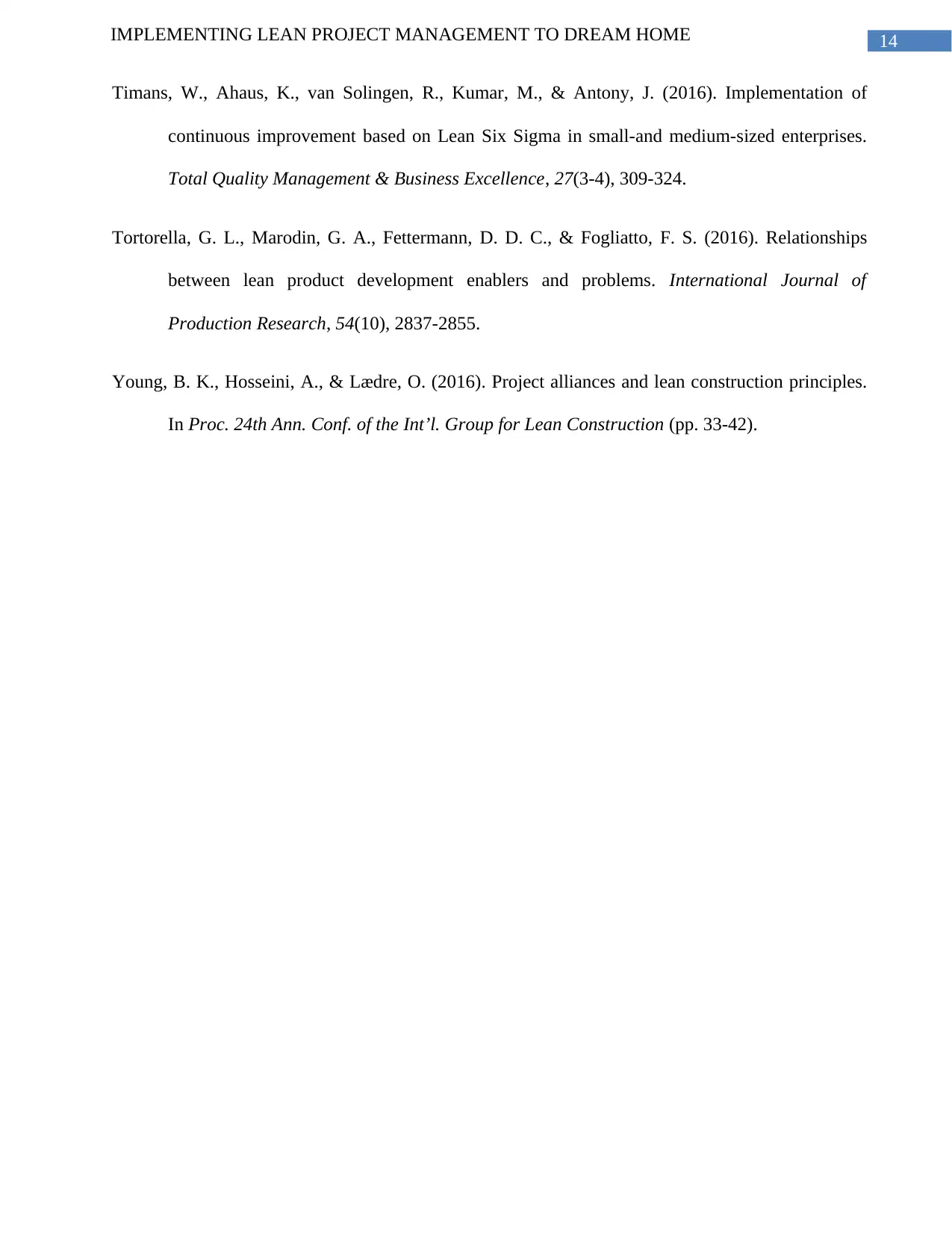
14IMPLEMENTING LEAN PROJECT MANAGEMENT TO DREAM HOME
Timans, W., Ahaus, K., van Solingen, R., Kumar, M., & Antony, J. (2016). Implementation of
continuous improvement based on Lean Six Sigma in small-and medium-sized enterprises.
Total Quality Management & Business Excellence, 27(3-4), 309-324.
Tortorella, G. L., Marodin, G. A., Fettermann, D. D. C., & Fogliatto, F. S. (2016). Relationships
between lean product development enablers and problems. International Journal of
Production Research, 54(10), 2837-2855.
Young, B. K., Hosseini, A., & Lædre, O. (2016). Project alliances and lean construction principles.
In Proc. 24th Ann. Conf. of the Int’l. Group for Lean Construction (pp. 33-42).
Timans, W., Ahaus, K., van Solingen, R., Kumar, M., & Antony, J. (2016). Implementation of
continuous improvement based on Lean Six Sigma in small-and medium-sized enterprises.
Total Quality Management & Business Excellence, 27(3-4), 309-324.
Tortorella, G. L., Marodin, G. A., Fettermann, D. D. C., & Fogliatto, F. S. (2016). Relationships
between lean product development enablers and problems. International Journal of
Production Research, 54(10), 2837-2855.
Young, B. K., Hosseini, A., & Lædre, O. (2016). Project alliances and lean construction principles.
In Proc. 24th Ann. Conf. of the Int’l. Group for Lean Construction (pp. 33-42).
1 out of 15
Related Documents
Your All-in-One AI-Powered Toolkit for Academic Success.
+13062052269
info@desklib.com
Available 24*7 on WhatsApp / Email
![[object Object]](/_next/static/media/star-bottom.7253800d.svg)
Unlock your academic potential
© 2024 | Zucol Services PVT LTD | All rights reserved.





